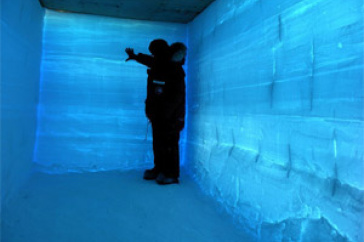Antarctic Project Coordinated by UNH Obtains Deepest Ice Core Ever Drilled by US

Inside a snow pit, a WAIS Divide researcher examines layers deposited by different storms. Credit: Kendrick Taylor, Desert Research Institute, Nevada System of Higher Education.
DURHAM, N.H. -- The West Antarctic Ice Sheet (WAIS) Divide project closed out its fifth drilling season on Friday, Jan. 28, 2011 after reaching a depth of 3,331 meters - about two miles - thereby deriving the deepest ice core ever drilled by U.S. researchers. The WAIS Divide project, for which the University of New Hampshire provides science coordination, is investigating the last 100,000 years of Earth's climate history. The ice at 3,331 meters fell as snow about 100,000 years ago.
"By improving our understanding of how natural changes in greenhouse gas influenced climate in the past, the science community will be able to do a better job of predicting future climate changes caused by the emissions of greenhouse gases by human activity," says the project's chief scientist, Kendrick Taylor of the Desert Research Institute.
The National Science Foundation's Office of Polar Programs funds the project, primarily through its Antarctic Glaciology Program.
"We have two more field seasons of work to complete the project, and reaching this goal should allow us to complete the project on schedule," says Julie Palais, program director.
The drilling site is about 600 miles from the South Pole where the ice flows out to the sea in opposing directions - an ice divide. The location was selected because it is the best place on the planet to determine how greenhouse gases have changed during the last 100,000 years.
The high annual snowfall at the site enables individual annual layers of snowfall to be identified and counted, much like counting tree rings, back to about 40,000 years. (Below that, the layers become too compressed to allow annual layers to be resolved.) Over time, the ice forms as snow is compacted at the surface by subsequent snowfall. The compacted snow contains dust, chemicals and atmospheric gases, which are trapped in the ice and are indicators of past climate. The deeper the ice, the further back in time measurements can be made.
Mark Twickler, who heads up the WAIS Divide Science Coordination Office at UNH, says the ice cores are five-inch diameter cylinders that get cut into one-meter (three feet) sections. They are sent by ship and refrigerated truck to the NSF National Ice Core Laboratory in Denver. The ice is then cut into smaller samples and sent to 27 investigators around the U.S. who make the measurements. Part of Twickler's job is to divvy up the precious ice samples depending on specific researcher's investigations.
At UNH, Twickler works with project operations manager Joe Souney on multiple aspects of the project. "While we do not do analysis on the core, we are responsible for a wide variety of tasks including hiring field workers to collect the core, organizing logistics, workshops, and data collection along with coordinating the processing of the core in Denver at the National Ice Core Laboratory," says Twickler.
In addition to measuring what the atmospheric concentrations of carbon dioxide, methane, and other gases were in the past, the research team can also determine what the surface air temperature was in the past by studying changes in the isotopic composition of the water that makes up the ice.
"Previous ice cores have shown that the current level of greenhouse gases is greater now than at any time during the last 650,000 years, and that concentrations today are increasing at the fastest rate," says Taylor.
The WAIS Divide project is specifically investigating the small timing offsets between past changes in the atmospheric concentration of greenhouse gases and changes in temperature. By understanding these timing offsets, the research team can determine the role changes in ocean circulation had in the release of carbon dioxide from the ocean and how an increase in carbon dioxide in the atmosphere warms the planet.
The project website is http://www.waisdivide.unh.edu, and a media guide is available at http://www.waisdivide.unh.edu/about/mediapublicguide.shtml.
The University of New Hampshire, founded in 1866, is a world-class public research university with the feel of a New England liberal arts college. A land, sea, and space-grant university, UNH is the state's flagship public institution, enrolling 12,200 undergraduate and 2,300 graduate students.
-30-
Editors and reporters: Mark Twickler of the WAIS Divide Science Coordination Office at UNH can be reached at 603-862-1991 and mailto:mark.twickler@unh.edu"
-
Media Contact
National Science Foundation | National Science Foundation | dwing@nsf.gov | 703-292-5344
Latest News
-
July 2, 2024
-
June 18, 2024
-
June 18, 2024
-
May 17, 2024
-
May 14, 2024

















































